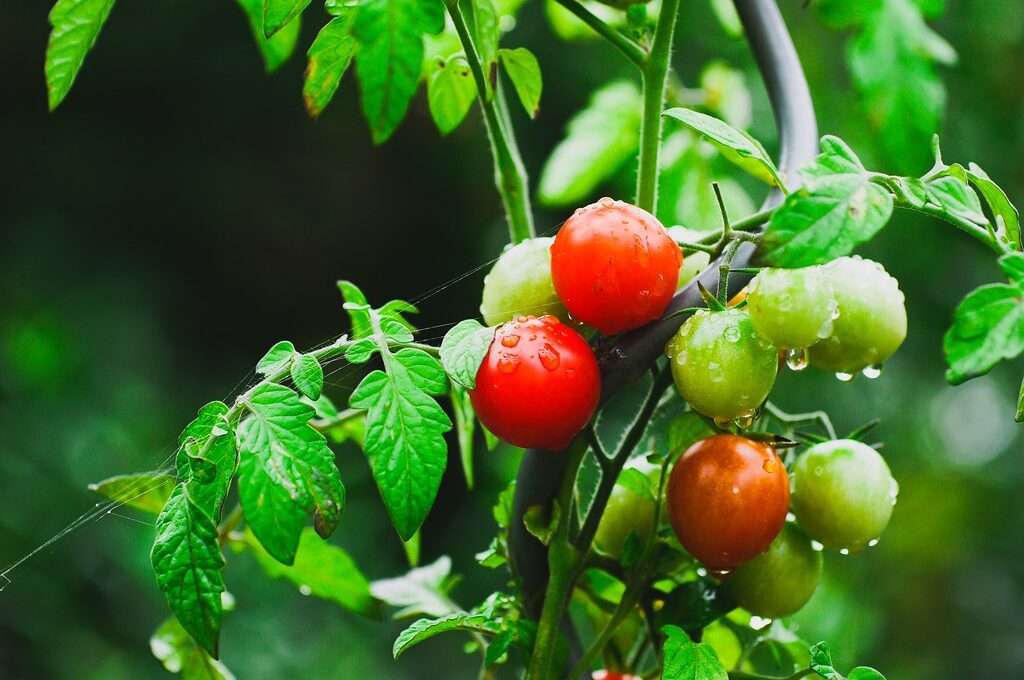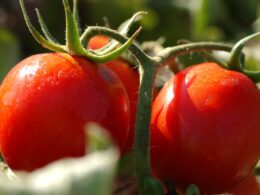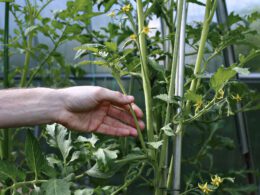You’ve put in the time and effort to grow your tomato plants, nurturing them from seedlings to thriving green foliage. Now, as you watch the fruit develop and ripen, you might be wondering if it’s time to cut back the top of your plant. You’re not alone; this is a common question among gardeners looking for ways to enhance their harvest while keeping their precious plants safe from pests and diseases.
In this article, we’ll explore both sides of the debate on whether or not topping your tomato plants is beneficial. We’ll discuss how tomato plants grow, the arguments for and against cutting off their tops, proper techniques for doing so, and alternative pruning methods that may provide similar benefits without causing harm.
By the end of this read, you’ll have all the information you need to decide what’s best for your beloved tomatoes – ultimately ensuring a bountiful harvest while maintaining your plant’s health and safety.
Understanding Tomato Plant Growth
Ever wondered how that tomato plant of yours actually grows? Well, let’s dive into the basics.
Tomato plants grow in two stages: vegetative growth and fruit production. During the vegetative growth stage, the plant focuses on growing taller and developing its leaves, stems, and roots. As it matures, it will shift its energy to producing flowers and eventually tomatoes.
Now let’s talk about your role in this process. Your job is to make sure the plant gets what it needs for healthy growth – sunlight, water, nutrients, and a little TLC. You’ll want to keep an eye on any signs of distress like yellowing leaves or stunted growth as these may be indicators that something isn’t quite right with your tomato plant. But don’t worry too much; most issues can be easily addressed with some simple adjustments.
So how does this all relate to cutting off the top of your tomato plant? Well, when you remove the top of your tomato plant (called ‘topping’), you’re essentially stopping vertical growth which encourages side branching and bushier foliage. This can lead to more sun exposure for lower branches and potentially more fruit production overall.
However, it’s important not to go overboard with pruning because excessive trimming could stress out your precious tomato plants! So remember – a little care goes a long way in helping your tomatoes thrive safely!
The Argument for Topping Tomato Plants
Believe it or not, topping those tomato plants can actually work wonders for their growth and fruit production! Topping is the process of cutting off the top of your tomato plant, usually just above a leaf node. This encourages the plant to stop growing vertically and instead focus its energy on producing more fruit. By redirecting the plant’s energy in this way, you’re ensuring a more bountiful harvest.
Topping helps prevent your tomato plants from becoming too tall and unmanageable. This makes it easier to tend to them and provide proper support. With less energy spent on vertical growth, your plants will put more resources into producing larger, juicier tomatoes. Topping can improve air circulation around your plants, which in turn reduces the risk of diseases caused by moisture buildup.
It’s important to note that topping is best suited for indeterminate tomato varieties as they continue to grow and produce fruit throughout the season. For determinate varieties, topping may not be necessary since these plants naturally stop growing after setting fruit. If you decide to try topping your tomato plants, remember that timing is crucial – aim for when they have already set some fruits but still have plenty of time left in their growing season.
So go ahead and give it a shot; you might just find yourself with happier, healthier tomato plants that reward you with an abundance of delicious fruits!
The Argument Against Topping Tomato Plants
While topping tomato plants can have its benefits, it’s not always a one-size-fits-all solution for every gardener’s situation. In fact, there are some compelling reasons to let your tomatoes grow free and wild.
For starters, allowing the plant to keep its topmost growth can actually lead to a higher overall yield of fruit. This is because the main stem will continue to produce new flowers and fruit-bearing branches as it grows taller. If you’re looking for maximum production from your plants, leaving them untopped may be the way to go.
Another reason not to top your tomato plants is that doing so can expose them to potential harm. When you remove the growing tip, you’re effectively creating an open wound on the plant – a perfect entry point for disease or pests. By leaving your plants intact, you’ll be giving them a better chance of staying healthy throughout their lifecycle.
Additionally, if you live in an area with strong winds or heavy rainstorms, taller plants with all their foliage intact can help protect lower-growing fruits from damage.
Letting your tomato plants grow without topping also means less work for you! Tending to these precious crops takes time and effort; pruning and managing topped plants can add extra tasks that might feel overwhelming or unnecessary when trying to enjoy gardening as a relaxing hobby.
Plus, non-topped tomato varieties often develop stronger root systems which allow them to access more water and nutrients from deeper within the soil – resulting in healthier plants overall!
So before reaching for those pruning shears, consider letting nature take its course; sometimes it really does know best!
Is Picking off Flowers and Cutting off the Top of Tomato Plants the Same Thing?
Picking flowers from tomato plants could lead to a negative outcome for your harvest. Although it may seem similar to cutting off the top of tomato plants, the consequences vary. Picking flowers prevents the formation of fruits, limiting the potential yield. On the other hand, cutting the top can stimulate growth and improve overall productivity. So remember, choose wisely when tending to your tomato plants.
How to Properly Top Tomato Plants
Topping tomato plants can be a beneficial pruning technique, but it’s important to know when and where to make the cut.
In this discussion, we’ll guide you through the proper tools and techniques for topping your tomatoes. This will ensure you get the best results from your garden while keeping your plants healthy and productive.
So let’s dive in and learn how to properly top those tomato plants!
When and Where to Make the Cut
Determine the precise moment and location for making that crucial snip on the tomato plant to encourage its optimal growth. Timing is everything, as topping your tomato plant too early may stunt its growth, while waiting too long can lead to leggy plants with decreased productivity. To ensure you’re making the cut at just the right time:
- When your tomato plant has reached a desirable height:
- For determinate varieties, wait until they’ve set fruit on the top cluster.
- For indeterminate varieties, top them about a month before your first expected frost.
Where to make the cut:
- Locate the main stem of your tomato plant and identify where new growth is emerging.
- Cut about one-quarter inch above a leaf node or lateral branch, ensuring you’re not removing any developing fruit clusters.
By carefully choosing when and where to make that all-important snip, you’re providing your tomato plants with an environment in which they can thrive.
This simple act will not only improve their overall health but also increase their yield of delicious tomatoes. With proper care and attention to detail, you can confidently tend to your garden, knowing that you’re nurturing strong, healthy plants – ultimately satisfying that innate desire for safety and security in both yourself and those who enjoy the fruits of your labor.
Tools and Techniques
Now that you’ve got the timing and location down, let’s dive into the essential tools and techniques for topping those tomato plants like a pro.
First up, you’ll need a pair of clean, sharp pruning shears or scissors. Ensuring your tools are sharp and clean helps to prevent damage to the plant and reduces the risk of spreading diseases between plants. Give your cutting tool a quick wipe with rubbing alcohol before beginning to keep things safe and sanitary.
When it comes time to make the cut, approach it with care and precision. Hold the stem just below where you want to remove it, then use your shears or scissors to make a clean cut at an angle about 1/4 inch above a pair of leaves or fruiting branch. This angled cut will help ensure water runoff doesn’t pool on top of your newly snipped stem – which could lead to rotting – keeping your tomato plant healthier in the long run.
Topping can be nerve-wracking at first, but with practice, you’ll soon become confident in making these crucial cuts for better growth and production!
Will cutting the top off my tomato plant affect the number of branches I should leave on the plant?
Yes, leaving branches on tomato plant after cutting the top off can affect the overall number of branches you should leave. While removing the top encourages the plant to focus on fruit production, the number of branches left can impact the plant’s overall growth and yield.
Alternative Pruning Methods
Consider other pruning methods to keep those vines healthy and thriving. One alternative to topping your tomato plants is the practice of selective pruning. This method involves removing only specific branches or leaves that are unhealthy, overcrowded, or blocking sunlight from reaching the lower parts of the plant. By focusing on these problem areas, you’re allowing for better air circulation and light penetration, which promotes healthier growth.
Another option is called ‘suckering,’ which targets the small shoots that grow between the main stem and leaf branches. These suckers can divert energy away from fruit production if left unchecked. Simply pinch off these unwanted growths with your fingers or use a pair of clean garden shears to remove them close to the main stem. This will redirect energy back into growing larger fruits and maintaining overall plant health.
If you’re worried about over-pruning or causing harm to your tomato plants, try adopting a less invasive approach known as ‘minimal pruning.’ With this technique, you’ll only remove yellowed or diseased foliage and leave most of the healthy growth intact. This method allows for more natural growth patterns while still providing some basic maintenance benefits like improved air circulation and reduced disease risk.
Remember that each plant is unique; experiment with different techniques to find what works best for your tomatoes while keeping their well-being in mind at all times.
Conclusion
So, should you top your tomato plants? It really depends on your goals and preferences as a gardener.
If you want to encourage more fruit production in a short amount of time, topping might be worth trying. But if you’re not comfortable with the idea or prefer a less hands-on approach, there are other pruning methods that can still help improve your plant’s health and productivity.
Ultimately, it’s up to you to decide what works best for your garden!









